Attached files
| file | filename |
|---|---|
| 8-K - FORM 8-K - EQUITY LIFESTYLE PROPERTIES INC | c60481e8vk.htm |

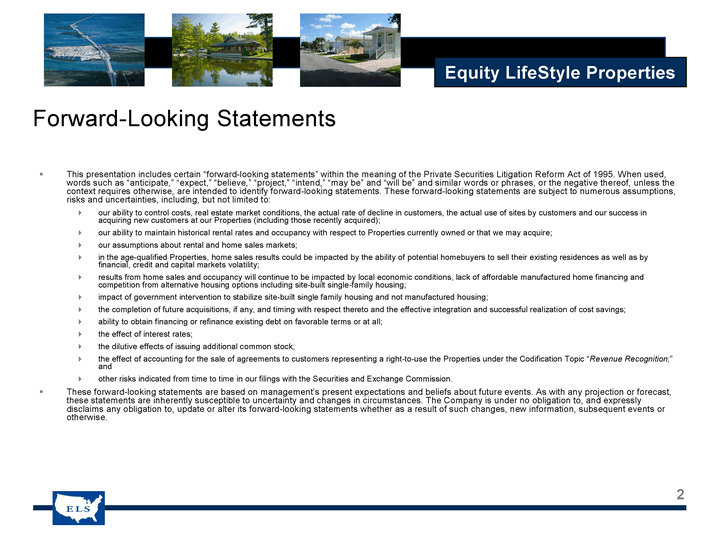
| Forward-Looking Statements This presentation includes certain "forward-looking statements" within the meaning of the Private Securities Litigation Reform Act of 1995. When used, words such as "anticipate," "expect," "believe," "project," "intend," "may be" and "will be" and similar words or phrases, or the negative thereof, unless the context requires otherwise, are intended to identify forward-looking statements. These forward-looking statements are subject to numerous assumptions, risks and uncertainties, including, but not limited to: our ability to control costs, real estate market conditions, the actual rate of decline in customers, the actual use of sites by customers and our success in acquiring new customers at our Properties (including those recently acquired); our ability to maintain historical rental rates and occupancy with respect to Properties currently owned or that we may acquire; our assumptions about rental and home sales markets; in the age-qualified Properties, home sales results could be impacted by the ability of potential homebuyers to sell their existing residences as well as by financial, credit and capital markets volatility; results from home sales and occupancy will continue to be impacted by local economic conditions, lack of affordable manufactured home financing and competition from alternative housing options including site-built single-family housing; impact of government intervention to stabilize site-built single family housing and not manufactured housing; the completion of future acquisitions, if any, and timing with respect thereto and the effective integration and successful realization of cost savings; ability to obtain financing or refinance existing debt on favorable terms or at all; the effect of interest rates; the dilutive effects of issuing additional common stock; the effect of accounting for the sale of agreements to customers representing a right-to-use the Properties under the Codification Topic "Revenue Recognition;" and other risks indicated from time to time in our filings with the Securities and Exchange Commission. These forward-looking statements are based on management's present expectations and beliefs about future events. As with any projection or forecast, these statements are inherently susceptible to uncertainty and changes in circumstances. The Company is under no obligation to, and expressly disclaims any obligation to, update or alter its forward-looking statements whether as a result of such changes, new information, subsequent events or otherwise. |

| ELS Overview One of the nation's largest real estate networks with approximately 300 properties containing almost 111,000 sites in 27 states and British Columbia ELS has a unique business model: ELS owns the land Leases individual developed sites to customers Customers own the units they place on the sites ELS site composition 46,000 manufactured or resort home sites 41,000 public RV sites for resort cottages (park models) and recreational vehicles 24,000 right to use sites ELS's rent position is prime Over 1,000,000 customer contacts |

| ELS Business Expansion (2003 - Current) Number of Sites Number of Properties = MH = RV (LifeStyle) 128 135 14 172 0 40 80 120 160 2003 Current 90.1% 9.9% 56.0% 44.0% 44,900 45,700 8,800 65,300 - 20,000 40,000 60,000 80,000 2003 Current 83.7% 58.8% 16.3% 41.2% |
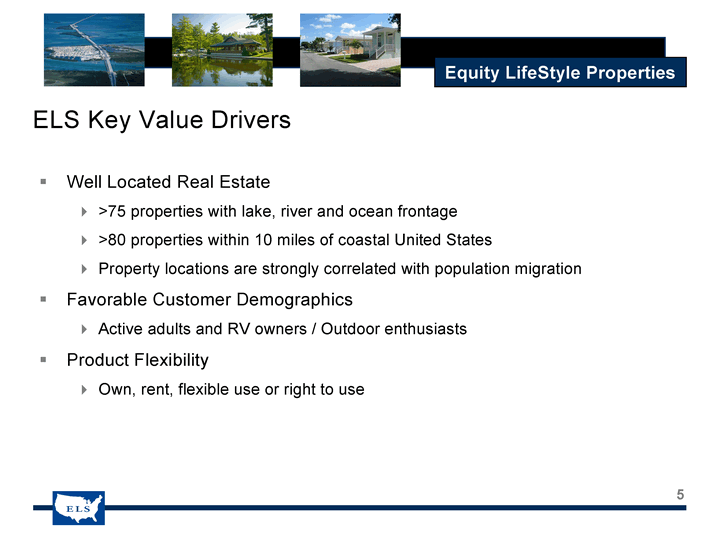
| ELS Key Value Drivers Well Located Real Estate >75 properties with lake, river and ocean frontage >80 properties within 10 miles of coastal United States Property locations are strongly correlated with population migration Favorable Customer Demographics Active adults and RV owners / Outdoor enthusiasts Product Flexibility Own, rent, flexible use or right to use |

| ELS Current Property Locations |
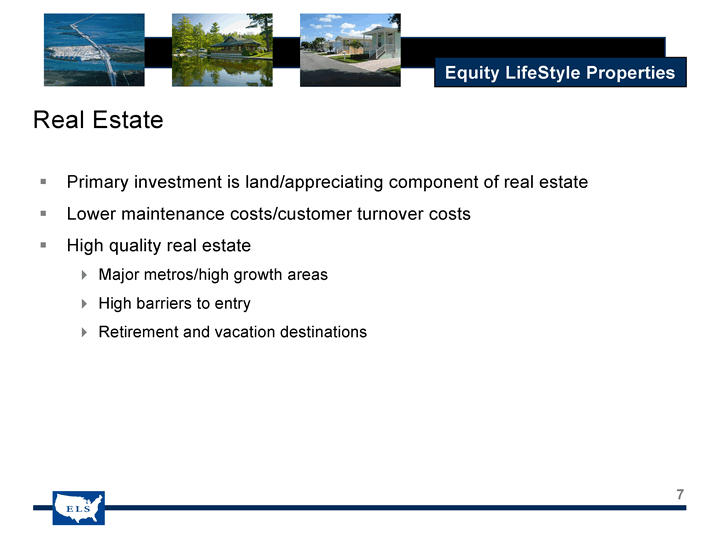
| Real Estate Primary investment is land/appreciating component of real estate Lower maintenance costs/customer turnover costs High quality real estate Major metros/high growth areas High barriers to entry Retirement and vacation destinations |
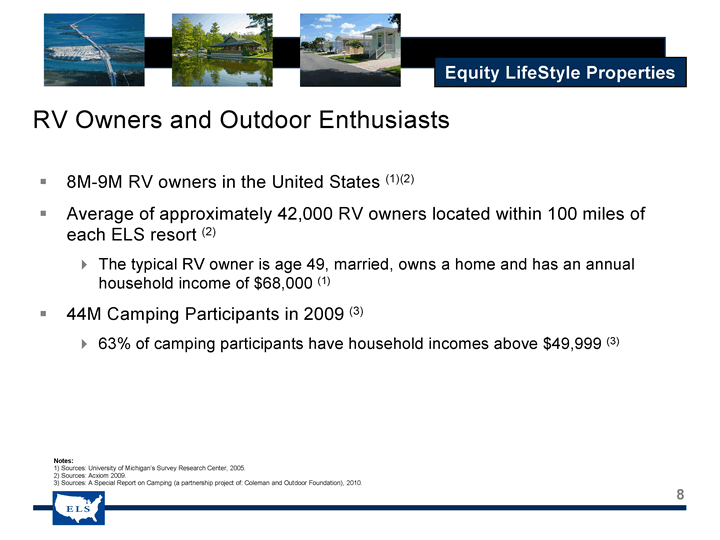
| 8M-9M RV owners in the United States (1)(2) Average of approximately 42,000 RV owners located within 100 miles of each ELS resort (2) The typical RV owner is age 49, married, owns a home and has an annual household income of $68,000 (1) 44M Camping Participants in 2009 (3) 63% of camping participants have household incomes above $49,999 (3) RV Owners and Outdoor Enthusiasts Notes: 1) Sources: University of Michigan's Survey Research Center, 2005. 2) Sources: Acxiom 2009. 3) Sources: A Special Report on Camping (a partnership project of: Coleman and Outdoor Foundation), 2010. |

| Customer Discovery (1) As our customers enter later life stages they tend to fall into our more stable customer buckets Transient RV Customer 36-55, married, kids, home owner Right to Use RV and Seasonal RV Customer 56-75, married, empty nester, home owner Annual RV and MH Customer 66-75, married, empty nester, home owner Note: 1) Source: Acxiom 2008. |
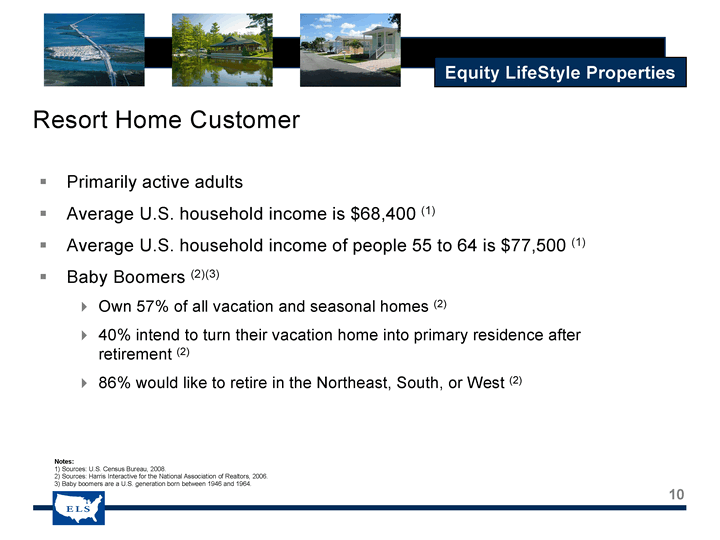
| Resort Home Customer Primarily active adults Average U.S. household income is $68,400 (1) Average U.S. household income of people 55 to 64 is $77,500 (1) Baby Boomers (2)(3) Own 57% of all vacation and seasonal homes (2) 40% intend to turn their vacation home into primary residence after retirement (2) 86% would like to retire in the Northeast, South, or West (2) Notes: 1) Sources: U.S. Census Bureau, 2008. 2) Sources: Harris Interactive for the National Association of Realtors, 2006. 3) Baby boomers are a U.S. generation born between 1946 and 1964. |
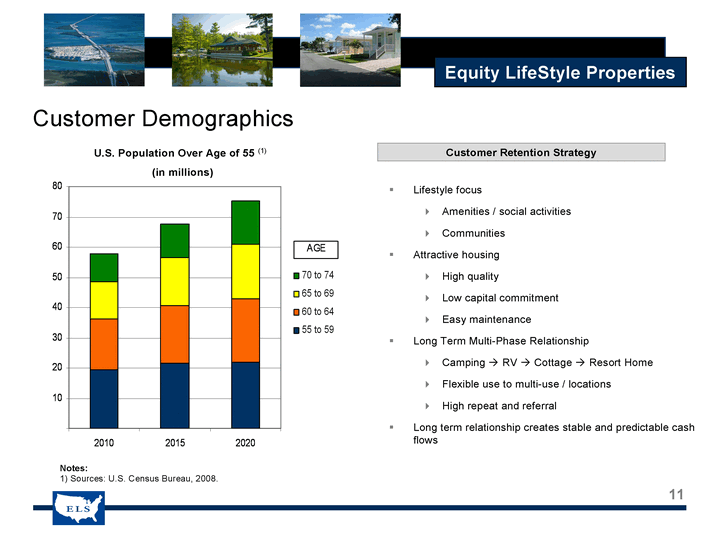
| Customer Demographics Customer Demographics U.S. Population Over Age of 55 (1) (in millions) Notes: 1) Sources: U.S. Census Bureau, 2008. Customer Retention Strategy Lifestyle focus Amenities / social activities Communities Attractive housing High quality Low capital commitment Easy maintenance Long Term Multi-Phase Relationship Camping ? RV ? Cottage ? Resort Home Flexible use to multi-use / locations High repeat and referral Long term relationship creates stable and predictable cash flows |

| ELS LifeStyle and Activities Recreation Golf, softball, fishing, tennis, swimming, shuffleboard Arts Concerts, shows, art fairs, crafts Education Seminars, One Day University Volunteerism Consider Others, fund raising |
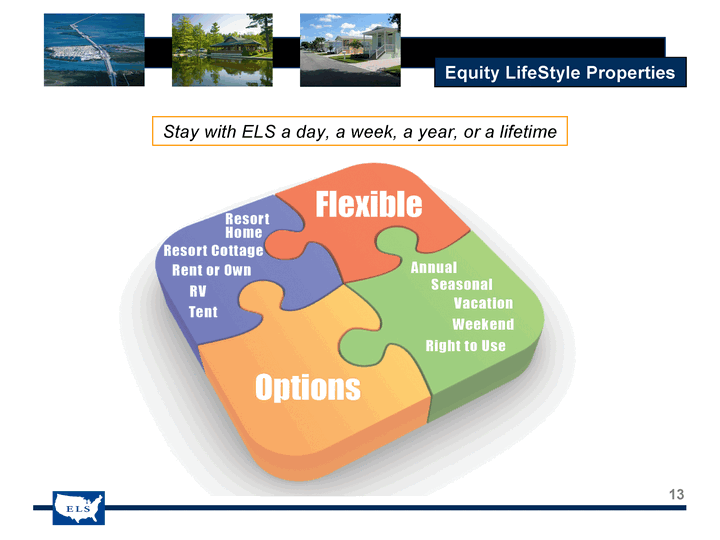
| Stay with ELS a day, a week, a year, or a lifetime |
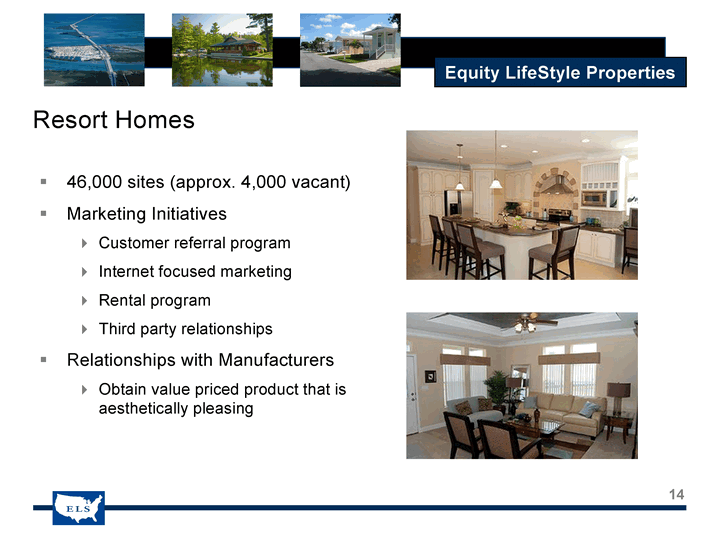
| Resort Homes 46,000 sites (approx. 4,000 vacant) Marketing Initiatives Customer referral program Internet focused marketing Rental program Third party relationships Relationships with Manufacturers Obtain value priced product that is aesthetically pleasing |

| RV Resorts (1) Annual/Seasonal Sites = 30,000 Transient Sites = 10,000 Thousand Trails Sites = 24,000 24,000 sites; 108,000 members Roughly 13,000 implied excess sites (less than 5 to 1 ratio) Industry standard ratio = 10 to 1 Note: 1) Excludes joint venture sites. |

| Steady, Predictable Revenue Streams Property Revenue Buckets (1) All Annual Revenue = 90.4% $495M Property Operating Revenues Notes: 1) Property revenue buckets reflect the 2009 property operating revenues from the 2010 core properties. See page 21 for the 2009 amounts and the definition of 2010 core properties. 2) Sources: University of Michigan's Survey Research Center 2005, Acxiom 2009, Statistical Surveys, US Census 2006. Extensive Customer Pool (2) ELS only needs a small percentage of this customer pool to feed its revenue streams 5.4% 4.2% 51.2% 15.0% 14.6% 9.6% |

| Financials |

| Total Market Capitalization IPO - March 1993 June 30, 2010 Market Capitalization $193 million $ 1.7 billion (1) Preferred Units - $200 million Mortgage Notes $103 million $1.5 billion Unsecured Notes - - Total Market Capitalization $296 million $3.4 billion Note: Utilizes $48.23 closing stock price at June 30, 2010, fully diluted. |
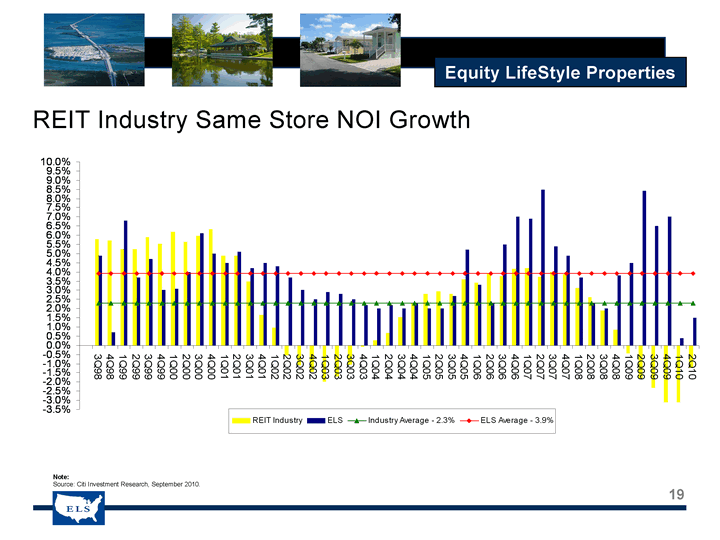
| REIT Industry Same Store NOI Growth Note: Source: Citi Investment Research, September 2010. |

| Track Record 1993 2010 FFO Per Share (1) $1.11 $3.55 Stock Price Performance (2) $12.88 $51.73 Dividend Paid Cumulative (3) $27.09 Total Return (4) 861% Notes: 1) See page 24 for definition of FFO. 2010 amount is the mid-point of the estimated 2010 FFO per share disclosed in the July 19, 2010 press release. 2) The 1993 stock price is split-adjusted; the 2010 price is the closing price as of August 31, 2010. 3) Source: SNL Financial. Includes dividends paid from IPO through August 31, 2010. 4) Source: SNL Financial from IPO through August 31, 2010 (calculation assumes dividend reinvestment). |

| 2010 Budget Assumptions Income From Property Operations (In Millions) Property Operations (excluding Property management): 2009 (1) 2010 Growth Factor (2) Community Base Rental Income $253.3 Resort Base Rental Income Right to Use Annual Payments Right to Use Contracts (3) 122.0 50.8 21.5 Utility and Other Income 47.4 __________ Property Operating Revenues (3) $495.0 Property Operating Expenses (4) (224.0) ___________ Income from Property Operations $271.0 1.5 - 2.0% ========== Notes: 1) Company's 2009 income from property operations for the 2010 core properties. 2010 Core properties include properties we expect to own and operate during all of 2009 and 2010. 2) Company's estimate of the growth of the 2010 Core in 2010 compared to 2009 performance. 3) Excludes the GAAP deferral of the 2009 right to use contract sales and the amortization of prior period sales. 4) Excludes the GAAP deferral of the 2009 commissions on right to use contract sales and the amortization of prior period commissions. |

| 2010 Budget Selected Financial Data (In Millions; except per share data) Notes: 1) Based on Company's estimate. 2) Excludes property management expenses and excludes the GAAP deferrals of right to use contract sales and related commissions. 3) See page 24 for definition of FFO. 4) Due to the uncertain timing and extent of right to use sales and the resulting deferrals, actual income could differ materially from expected net income. 2010 Budget (1) $276 1 (56) 12 (107) 126 (69) (11) (6) $40 $1.23 - $1.33 $3.50 - $3.60 35.5 Income from Property Operations - 2010 Core (2) Income from Property Operations - Non-Core (2) Property Management and corporate general and administrative expenses Other Income and Expenses Financing Costs and Other Funds from Operations (FFO) (3) Depreciation on Real Estate and Other Deferral of right-to-use contract sales revenue and commission, net (4) Income Allocated to Common OP Units Net Income Available to Common Shares (4) Net Income Per Common Share - Fully Diluted FFO Per Share - Fully Diluted Weighted Average Fully Diluted Shares Outstanding |

| Core Occupancy & Growth Rates MH occupancy as of August 2010 YTD Up 56 sites compared to December 31, 2009 August 2010 YTD as compared to August 2009 YTD: MH base revenue growth is up 2.2% Resort base revenue growth is up 3.0% Right-to-use annual payments 2010 budget is 93% earned or prepaid as of August 2010 YTD (comparable to August 2009 YTD) |

| Non GAAP Financial Measures Funds from Operations ("FFO"), is a non-GAAP financial measure. We believe that FFO, as defined by the Board of Governors of the National Association of Real Estate Investment Trusts ("NAREIT"), is generally an appropriate measure of performance for an equity REIT. While FFO is a relevant and widely used measure of operating performance for equity REITs, it does not represent cash flow from operations or net income as defined by GAAP, and it should not be considered as an alternative to these indicators in evaluating liquidity or operating performance. We define FFO as net income, computed in accordance with GAAP, excluding gains or actual or estimated losses from sales of properties, plus real estate related depreciation and amortization, and after adjustments for unconsolidated partnerships and joint ventures. Adjustments for unconsolidated partnerships and joint ventures are calculated to reflect FFO on the same basis. We receive up- front non-refundable payments from the sale of right-to-use contracts. In accordance with GAAP, the upfront non-refundable payments and related commissions are deferred and amortized over the estimated customer life. Although the NAREIT definition of FFO does not address the treatment of nonrefundable right-to-use payments, we believe that it is appropriate to adjust for the impact of the deferral activity in our calculation of FFO. We believe that FFO is helpful to investors as one of several measures of the performance of an equity REIT. We further believe that by excluding the effect of depreciation, amortization and gains or actual or estimated losses from sales of real estate, all of which are based on historical costs and which may be of limited relevance in evaluating current performance, FFO can facilitate comparisons of operating performance between periods and among other equity REITs. We believe that the adjustment to FFO for the net revenue deferral of upfront non-refundable payments and expense deferral of right-to-use contract commissions also facilitates the comparison to other equity REITs. Investors should review FFO, along with GAAP net income and cash flow from operating activities, investing activities and financing activities, when evaluating an equity REIT's operating performance. We compute FFO in accordance with our interpretation of standards established by NAREIT, which may not be comparable to FFO reported by other REITs that do not define the term in accordance with the current NAREIT definition or that interpret the current NAREIT definition differently than we do. FFO does not represent cash generated from operating activities in accordance with GAAP, nor does it represent cash available to pay distributions and should not be considered as an alternative to net income, determined in accordance with GAAP, as an indication of our financial performance, or to cash flows from operating activities, determined in accordance with GAAP, as a measure of our liquidity, nor is it indicative of funds available to fund our cash needs, including our ability to make cash distributions. |
